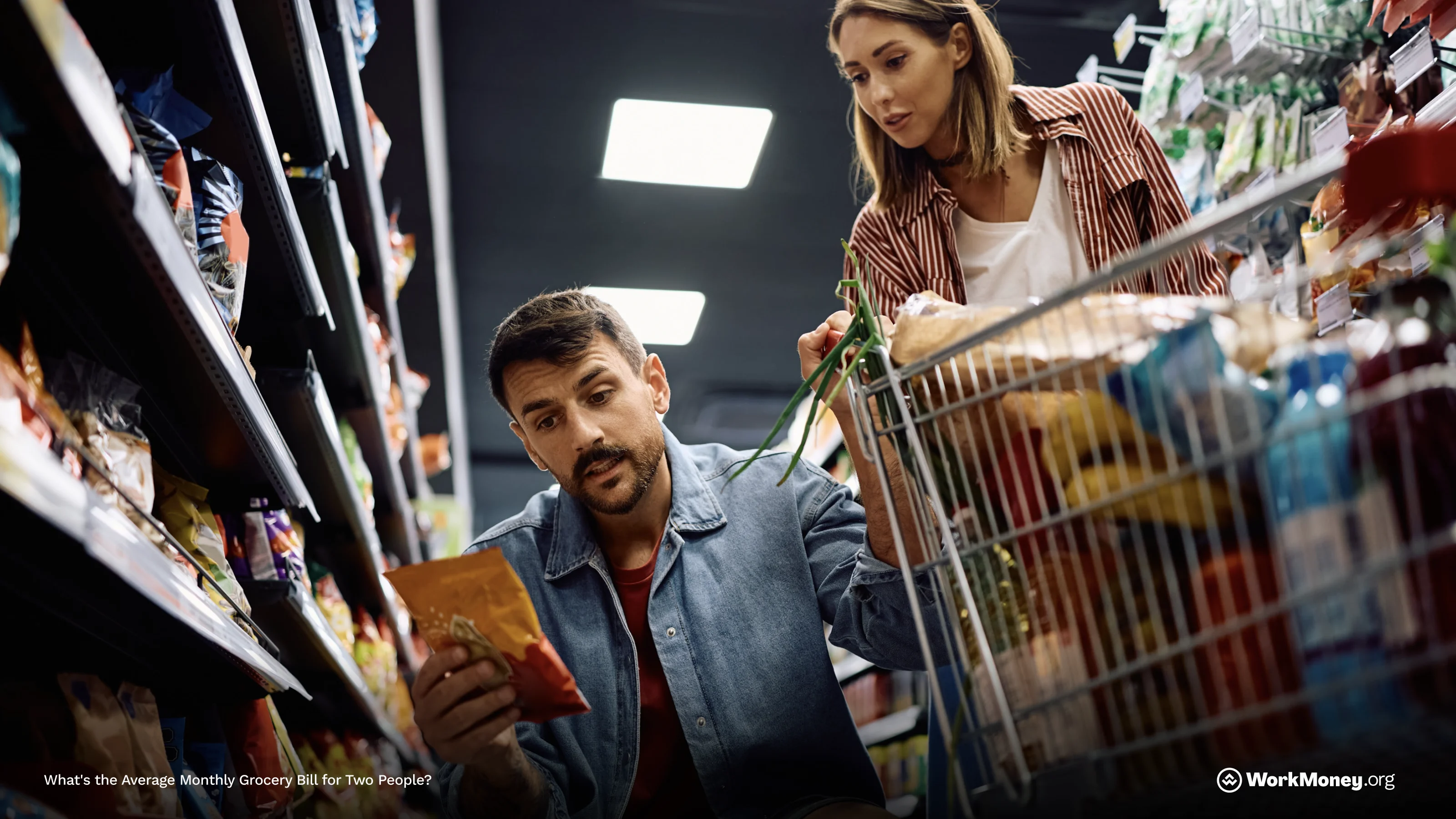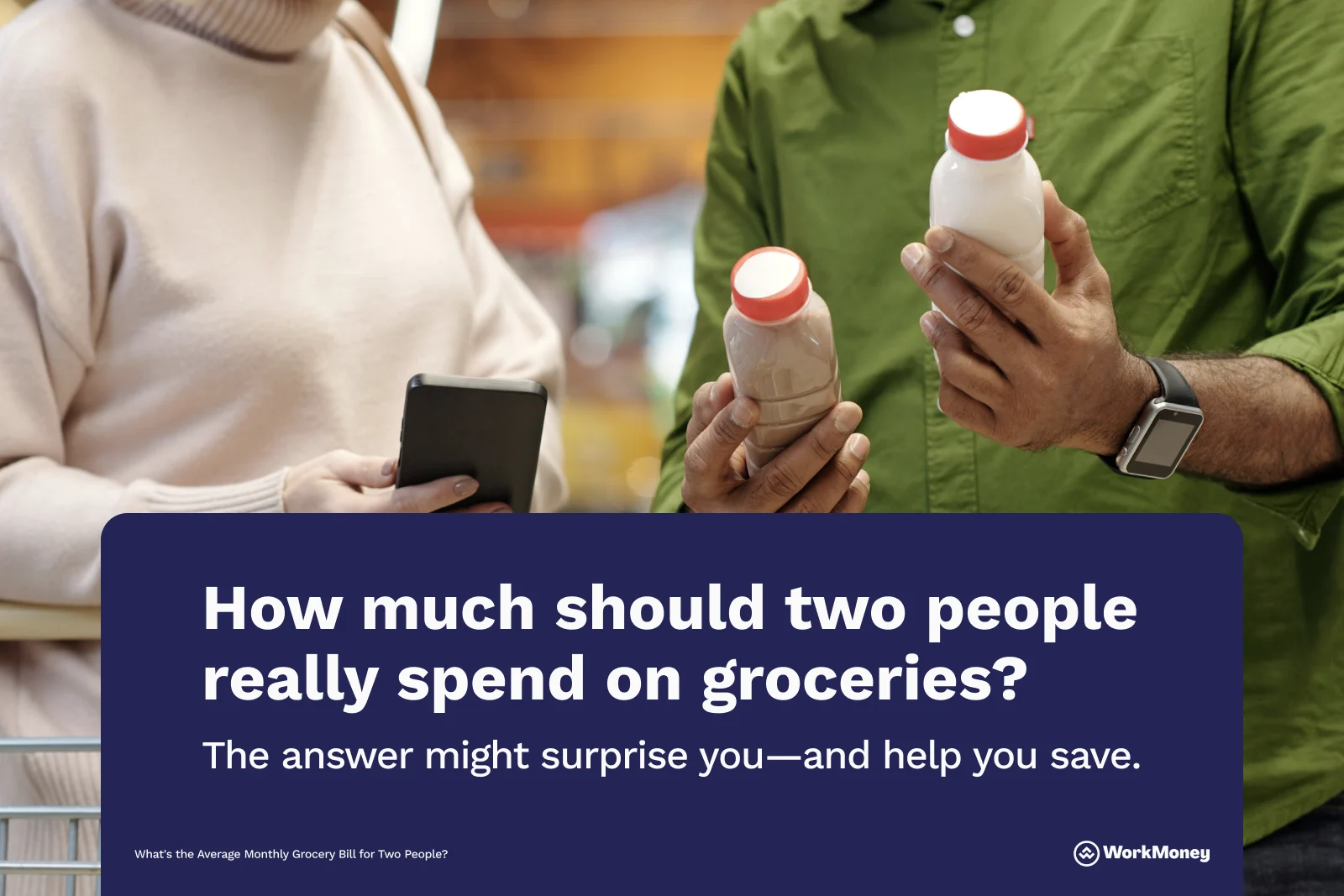What's the Average Monthly Grocery Bill for Two People?
Your monthly grocery bill isn’t just about how often you shop—it’s shaped by lifestyle choices, habits, and even your zip code

Grocery shopping for two people comes with a major advantage: you can split meals and take advantage of bulk buying more effectively than a single person. This can lead to some savings. For example, a LendingTree study from 2021-2022 found that grocery expenses increased at a slower pace for a two-person household compared to a single-person household.
Right now, the average grocery bill for two people ranges from $570-$876 per month, according to the USDA. Where you fall in this range depends on where you live, where you shop, and what you purchase. Some of these factors are out of your control, such as the rising costs of groceries in the last five years. However, there are several factors you can control to help control and potentially lower your monthly grocery bill.
The WorkMoney team wants to ensure you and your family are meeting your financial goals, as well as being able to get the nutritious food you want.

What the Data Says
Like anything related to spending, it depends on the person and their needs. The best way to navigate the average monthly grocery bill for two people is to refer to the USDA Food Plans, which are released on a monthly basis.
Here are the numbers for the April 2025 USDA Cost of Food At Home report.
Age Group | Low-Cost | Moderate-Cost | Liberal |
Child | |||
1 year | $156.90 | $177.00 | $215.30 |
2-3 years | $164.90 | $198.40 | $241.50 |
4-5 years | $171.00 | $210.60 | $256.00 |
6-8 years | $247.40 | $290.20 | $339.90 |
9-11 years | $259.70 | $332.60 | $387.70 |
Women | |||
12-13 years | $258.00 | $306.00 | $382.40 |
14-18 years | $259.50 | $309.80 | $382.80 |
19-50 years | $264.90 | $322.20 | $410.30 |
51-70 years | $257.40 | $317.70 | $380.80 |
71+ years | $257.00 | $315.00 | $375.60 |
Men | |||
12-13 years | $303.70 | $376.40 | $441.10 |
14-18 years | $309.20 | $387.00 | $450.00 |
19-50 years | $304.90 | $382.80 | $465.70 |
51-70 years | $286.10 | $360.00 | $428.70 |
71+ years | $284.20 | $348.40 | $428.40 |
Again, these are national averages, so it’s important to take this information with a grain of salt, as your situation may look different.
Factors Influencing Your Grocery Bill
Your monthly grocery bill isn’t just about how often you shop—it’s shaped by a range of lifestyle choices, habits, and even your zip code. Here’s a closer look at what can drive those costs up or down:
Strategies to Reduce Your Grocery Spending
Meal Planning Is Everything
Before you walk into the grocery store, it’s important to have a set plan of what you need to purchase. Without an established list, you could find yourself buying items you don’t need and spending more than you need to.
By planning ahead, you can find the best days and times to visit your local grocery store when specific items are marked down.
You can also search on Instacart to see if items are marked down, or if the platform is running a promotion to make your grocery bill even cheaper.
Smart Shopping
As you’re shopping, take your time to compare options. Looking at unit pricing, like the cost per ounce can help you get the best bang for your buck. If you visit one store (or a few) regularly, find out if there is a loyalty program or digital coupons you can use to cut your bill even further.
Setting Your Own Grocery Budget for Two
The best way to ease any anxiety or worry about spending at the grocery store is to find a number that works for both of you to spend. Once you have that number in mind, you can then begin planning meals that fit into that budget.
Here’s how you can create a realistic grocery budget for two people:
Track Your Overall Current Spending
Start by understanding how much you're already spending on all of your expenses. Review recent bank or credit card statements and look specifically for grocery store purchases. Some people prefer to write things down, or you can use a budgeting app like YNAB or PocketGuard to categorize and track your expenses. By doing this, you can identify where you may be underspending and use each dollar you bring in efficiently.
Use The Envelope Method
One method that works for some is to have a physical envelope with the amount of money you can spend monthly at the grocery store. This sets a hard line for people to ensure they stay within a spending limit.
Final Thoughts
The average costs for a monthly grocery bill shouldn’t be used as a hard figure. There are too many variables to consider for a two-person household. Instead, use these numbers to understand if you’re over- or underspending, and make the adjustments necessary.
About the Author

Brett Holzhauer
Brett Holzhauer is a Certified Personal Finance Counselor (CPFC) who has reported for outlets like CNBC Select, Forbes Advisor, LendingTree, UpgradedPoints, MoneyGeek and more throughout his career. He is an alum of the Walter Cronkite School of Journalism at Arizona State. When he is not reporting, Brett is likely watching college football or traveling.

